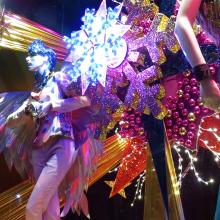
Multrees Walk evokes strong emotions in some locals. Jaundiced of Claremont, for example, admits to being drawn to its luxury retail outlets and simultaneously disgusted by them.
Since its completion in 2003, he confides, he has felt both attracted to the more-money-than-taste set spending fortunes on crimson joys and glistering gewgaws here in December, and impelled to creep up behind them whispering with rancid breath ‘Merry Christmas, matey. You too will die.’
With such sumptuary thoughts in mind, Spurtle spent a thrawn half hour window-shoplifting in Multrees Walk this evening, and can report that it has survived the howling storm.
Multrees Hill on which the Walk stands, has also been spelt Moultrie’s, Moultrey’s, Moultray’s and Multersey’s; all variations deriving from the surname of Robert Multrere, an Edinburgh burgess who owned land here in the 16th century.
Stuart Harris, in The Place Names of Edinburgh (1996), notes that the area – particularly the steepest part overlooking the road to Leith – was also known in the 18th century as Bunkers Hill (from the Scots word for heaps of rocks).
By some peculiar coincidence, the only other book written by Harris – A Future for the Past – he co-authored in 1961 with architectural conservationist, and film and TV actor, Moultrie Kelsall.
Where shall we go next? Send your photo or suggestions for our next seasonal snapshot by email spurtle@hotmail.co.uk on Facebook Broughton Spurtle or Twitter @theSpurtle